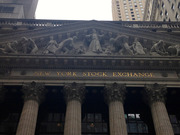For questions email info@shorecapmgmt.com
|
The Applied Research Company and Shore Capital Research LLC have joined together on a futures market research report to be published very soon. Stay tuned for more details.
For questions email info@shorecapmgmt.com
0 Comments
 Planet Microcap Ep. 7 - Commodity Futures Market Roundtable with host Robert Kraft and guests Mark Shore (Shore Capital Research) and Shelly Kraft (StockNewsNow.com). Click here to listen to the episode In this episode, the guests cover the following topics:
Mark Shore has more than 25 years of experience in the futures markets and managed futures, publishes research, consults on alternative investments & conducts educational workshops. www.shorecapmgmt.com email: info@shorecapmgmt.com Mark Shore is also an Adjunct Professor at DePaul University’s Kellstadt Graduate School of Business, where he teaches the only known accredited managed futures course in the country. He is also a Board Member of the Arditti Center for Risk Management at DePaul University. Past performance is not necessarily indicative of future results. There is risk of loss when investing in futures and options. Futures and options can be a volatile and risky investment; only use appropriate risk capital; this investment is not for everyone. The opinions expressed are solely those of the author and are only for educational purposes. Please talk to your financial advisor before making any investment decisions.  National Introducing Brokers Association (NIBA) Presents: 2015 NIBA Chicago Annual Conference Conference Schedule -Registration & Continental Breakfast: 9:30AM -NFA Rep Update: 10AM - 10:50AM -The El Nino Effect: Grains, Livestock, & Financials - Sponsored by INTL FC Stone: 11AM - 12:00PM -Box Lunches Available - Sponsored by CME Group: 12:00PM -Luncheon Speech - Blu Putnam, Chief Economist, CME Group - 12:30PM - 1:15PM -One Thing I've Always Wanted to Ask- Sponsored by MidlandIRA: 1:30PM - 2:15PM -Coffee Break: 2:15PM - 2:30PM -Cybersecurity Before & After the Breach- Sponsored by Nadex: 2:30PM - 3:30PM -Cybersecurity What Every IBs & CTAs Need to Know- Sponsored by RJ O'Brien: 3:45PM - 4:45PM -Cocktails: 5PM Date: Thursday September 24, 2015 Venue: CME Group Building 20 S. Wacker Drive, Chicago, IL For more information and registration click here About the NIBA: was established as a not-for-profit association in 1991. Before NIBA existed, Introducing Brokers (IBs) and Commodity Trading Advisors (CTAs) had no central organization to ensure that they were represented within the industry. Now, through the efforts of dedicated members and volunteers, NIBA has continued to grow in both size and influence and is well respected throughout the markets.  CTAExpo LLC Presents: Chicago CTA Expo 2015 CTA Expo is designed to provide Commodity Trading Advisors and Forex traders the foundation of knowledge they need from both an operational and marketing perspective to raise additional clients, and the opportunity to network with family offices, capital raisers, professional clients and allocators looking to identify trading talent as a source of alpha. Topics include: -THE FUTURES INDUSTRY...WHERE WE ARE, WHERE ARE WE GOING -CRYPTOCURRENCIES...ARE THEY A VIABLE TRADING VEHICLE AND SOURCE OF ALPHA -THE FAMILY OFFICE MARKET PLACE - STRATEGIES FOR INVESTORS AND MANAGERS -HITTING IT OUT OF THE PARK...HOW TO CONNECT WITH YOUR FIRST PITCH -KEYNOTE PANEL - WAR STORIES FROM THE TRENCHES -INSTITUTIONAL INVESTORS AND WHAT THEY LOOK FOR IN A MANAGER -PLATFORMS..THEIR SELECTION AND USE FOR MANAGERS AND INVESTORS -MANAGER OPERATIONAL STRUCTURING AND COMPLIANCE AND THEIR IMPORTANCE IN THE ALLOCATION DECISION Speakers Include: Bryan Johnson (JOHNSON & CO.) Frank Pusateri (CTA Expo LLC) Bucky Isaacson (CTA Expo LLC) Gerry Corcoran, CHAIRMAN AND CEO (R.J. O’BRIEN) CHAIRMAN (FUTURES INDUSTRY ASSOCIATION) Alan Snyder, PRESIDENT (SHINNECOCK CAPITAL) Todd Horsager (COMPASS STRATEGIC INVESTMENTS) Lauralouise Duffy, CHIEF EXECUTIVE OFFICER (GLOBAL FUND EXCHANGE GROUP LLC.) Anthony Birbilis, MANAGING DIRECTOR (COHESION PARTNERS INC.) Lancelot Frick, PRESIDENT (FRICK CAPITAL), Tim Pickering, PRESIDENT (AUSPICE CAPITAL ADVISORS, LLC.) Joan Esposito, FOUNDER (J2 STRATEGIC COMMUNICATIONS.) Ginger Szala, PRINCIPAL (GINGER SZALA INC) Emil van Essen, CHIEF EXECUTIVE OFFICER (VAN ESSEN AND ASSOCIATES) Ted Kingsbery, PRESIDENT (LIBERTY HERITAGE GROUP, LLC.) Frank Franiak, PRESIDENT (WOODFIELD FUND ADMINISTRATION, LLC.) MARTY EHRLICH, FOUNDER (SUNRISE CAPITAL PARTNERS, LLC.) Michael Dubin, MANAGING DIRECTOR (SILVERCREST ASSET MANAGEMENT GROUP, LLC.) Mark de Souza, CIO (COHESION PARTNERS, INC.) Dr. Bob Swarup, PRESIDENT (CAMDOR GLOBAL) David Young, PRESIDENT (GEMINI ALTERNATIVE FUNDS, LLC.) Mark E. Ruddy, Esq., PRINCIPAL PRINCIPAL (RUDDY LAW OFFICES, PLLC) John Euler, FOUNDER (EAM COMPLIANCE ADVISORS) Kate Dressel, PRESIDENT (STRATEGIC COMPLIANCE SOLUTIONS, LLC.) Date: Thursday, September 17, 2015 Venue: UBS Center, One North Wacker Drive, Chicago, IL For more information and registration click here  John Lothian News Presents: 3rd Annual MarketsWiki Education 2015 New York World of Opportunity Summer Intern Education Series The series will feature speakers from around the financial industry who will present short 10 to 15 minute talks covering the entire scope of the markets, from exchanges to trading firms, indexes, regulation and technology. Interns and new employees will get personal stories as well as valuable information about trends in the markets and what it takes to succeed in this industry. This is a great opportunity to introduce young talent to the financial space, give them some ideas on how and where they can get started, and help expand the industry in the years to come. The event will be a one-day, two session event on July 15 in New York, hosted at the New York Stock Exchange. Each session is 90 minutes. In addition, 20 lucky attendees will be given a tour of the trading floor between the sessions. Also, the IFM has contributed six Series 3 exam courses, which we will distribute to attendees in New York via a drawing at the event. Speakers:
Date: July 15th, 2015 Time: 1 p.m. and 3:30 p.m. (Please arrive at the NYSE by 12:30 p.m. or 3 p.m. to be processed through security) Venue: New York Stock Exchange 11 Wall Street, NYC, NY For more information and registration click here  By Mark Shore Summary This paper examines seven very popular myths and misconceptions held by both retail and institutional investors regarding managed futures. This paper updates the original version written in 2011. These myths have persisted for several years. As investors are becoming more aware of the potential use of managed futures for asset allocation and portfolio diversification, knowing if the myths are true or false, is critical for an investor’s understanding and appreciation of managed futures. Decoding the Myths of Managed Futures 2015 From presenting at more panel events, instructing workshops on alternative investments and teaching my managed futures/ global macro course at DePaul University in the last several years, I found it was time to update the original paper written in 2011 with additional myths added to the list. The demand for alternative investments continues to grow as investors are seeking more ways to decrease their correlation risk and tail risk of their portfolio. After the dot com bubble and the recession in the early 2000s more investors realized the need for wider diversification beyond stocks and bonds. More recently since the financial crisis the demand to reduce correlation risk and tail risk continues to grow. Managed futures (AKA Commodity Trading Advisors), a subset of alternative investments and sometimes categorized under global macro hedge funds continues to grow in popularity. However, many old myths still persist about the investment product, the managers and the due diligence of the managers. As of the end of 2014 assets under management have grown by 736% since 2000 and by 53% since 2008, according to BarclayHedge. 2011, 2012 and 2013 were challenging years for the returns of managed futures and the product found itself out of favor. But no one has a crystal ball to know when markets change and the 2nd half 2014 gave CTAs a positive year while equities were experiencing greater volatility in the later part of 2014. As of March 2015, CTAs continue to profit. A fair amount of the recent growth in managed futures has been driven by the increasing interest for both commodity related investments as well greater non-correlation of portfolio allocations. Below are some of the myths and misconceptions of managed futures:
1: Mysterious “Black Box” Trading Systems Over the years I’ve often heard investors or allocators state “we don’t understand or can’t get comfortable with the systematic trading models” and “they are black boxes, so we stay away from them.” Systematic trading models are quantitative computerized trading models. In earlier years, many CTAs were cautious of fully explaining their models due to replication risk. However in more recent years there is a trend towards CTAs explaining their models. But the transparency by the CTA is not enough. It also involves the investors and allocators to do their research in understanding the concepts and terminology of the asset as they do their due diligence, just as they would for any other investment. 2: Hedge or Insurance against Equities Many believe that managed futures are a hedge or insurance against equities. This is not true. CTAs tend to be non-correlated to equities. This means their returns are independent of equity returns. The independent returns are primarily due to CTAs trading various commodity and financial markets and they can be long, short, neutral or spreading in those markets. In the last 20 years managed futures have shown moments of having a positive correlation to equities when equities rally and in other moments a negative correlation to equities when equities decline. Over time the correlation cycles between positive and negative. But they tend to show positive performance when there are “shocks” to the various markets or the economy such as in the early 2000’s and in 2008. A CTA does not care about the direction of the market they trade, but only that there is enough of a move to create a profit. 3: Only Commodities Are Traded Because the managers who trade futures are called Commodity Trading Advisors (CTAs), there is a myth that only commodities are traded. Some CTAs do trade only commodities or only trade one market or sector such as corn or the grain sector. But many trade only financial futures such as stock index futures, bond futures or currency futures or forwards. Diversified CTAs may trade both financial and commodity futures. 4: Managed Futures Are Volatile Some CTAs can be volatile, just as any other investment has the potential to be volatile or risky. However, if you look at volatility in terms of the Sharpe ratio and or standard deviation than you are also assuming the return distributions are a normal (bell-curve) distribution. CTAs may have low Sharpe ratios, high standard deviations, thus one would believe they are very risky and volatile. However, the low Sharpe ratio and high standard deviation are often derived from positive skewness of the return distribution due to risk management policies. One must understand the source of volatility returns. Volatility is similar to cholesterol; there is good volatility and bad volatility. Good volatility is derived from positive returns and the bad volatility derived from negative returns. The Sortino ratio and S-ratio are probably more informative in understanding risk-adjusted returns for a non-normal distribution than the Sharpe ratio or standard deviation. It may sound counter-intuitive, but adding an investment with high a standard deviation may actually reduce the portfolio’s volatility due to the positive skewness. In doing so to analyze the investment not as a standalone investment, but how does it compliment the portfolio. 5: Managed Futures Funds Are All the Same Some investors will ask “why do I need to invest in more than one CTA? Aren’t all CTAs the same?” The answer to that is NO! This topic can be detailed in a separate discussion, but they are not all the same for some basic reasons: 1) Some CTAs may trade different markets or varying number of markets. 2) Their time horizons or average trade duration may vary. 3) How they get into or out of positions may vary. 4) How they manage risk, one of the most important components of the trading system may vary among the CTAs. As I tell my students at DePaul University, the risk management of the positions may make or break a manager. 6: CTA Indices Contain Survivorship Bias Some investors will refrain from investing in managed futures because the indices include survivorship bias. They are correct, the indices usually do contain survivorship bias. This bias relates to managers being taken out of the index because they no longer meet a certain requirement to be in the index or they are no longer in business. Managers may also be taken out of an index because they stop reporting to the databases. One common reason for a manager to stop reporting their returns is if they reach a certain asset size and are no longer seeking to raise funds. What is often missed is that most investment indices do include survivorship bias. For example, General Electric was one of the original components in the Dow Jones index. They are now the only remaining original constituent. Over the decades DJ and S&P have added and removed companies from their respective indices. If survivorship bias is a reason for an investor to avoid investing in managed futures then why isn’t the same logic applied to equities? 7: All CTAs are Large Firms Often new investors to the managed futures space may know of a few large CTAs and think all CTAs are large firms with hundreds of millions if not billions of dollars under management, millions spent on technology, a large research staff and a deep infrastructure. However it is more common for a CTA to be a small business. They will often have from 2 to 10 employees. Using easily accessible technology and many back office functions outsourced to third party firms. This shouldn’t take away from investing in the smaller “emerging” managers, but to understand and appreciate the makeup of the industry. In summary, we have discussed some of the myths or misconceptions that have persisted over the years regarding managed futures. As the industry has become more transparent of their research and demand for non-correlated assets have increased, there is a need for investors to do their research, understand the product, as they would with any other asset class they explore to invest in and understand the profile of the managers they investigate. Copyright ©2015 Mark Shore. Contact the author for permission for republication at info@shorecapmgmt.com Mark Shore publishes research, consults on alternative investments and conducts educational workshops. His research can be found at www.shorecapmgmt.com Mark Shore is also an Adjunct Professor at DePaul University's Kellstadt Graduate School of Business in Chicago where he teaches a managed futures/ global macro course. Past performance is not necessarily indicative of future results. There is risk of loss when investing in futures and options. Always review a complete CTA disclosure document before investing in any Managed Futures program. Managed futures can be a volatile and risky investment; only use appropriate risk capital; this investment is not for everyone. The opinions expressed are solely those of the author and are only for educational purposes. Please talk to your financial advisor before making any investment decisions.  The Professional Risk Managers' International Association (PRMIA) and CME Group Present Innovations in Commodity Investing The discussion will cover changing fundamentals for commodity investors such as backwardation and correlation; new ways to access commodity markets such as ETFs, swaps and futures and other emerging trends in the commodity markets. This event is sponsored by the CME Group and PRMIA in association with CAIA. Speakers include: READ MORE Follow Mark Shore on Twitter, Facebook and Linkedin Mark Shore has more than 25 years of experience in the futures markets and managed futures, publishes research, consults on alternative investments and conducts educational workshops. www.shorecapmgmt.com Mark Shore is also an Adjunct Professor at DePaul University’s Kellstadt Graduate School of Business, where he teaches the only known accredited managed futures course in the country. He is also a Board Member of the Arditti Center for Risk Management at DePaul University.  By Mark Shore We drink it every day; we love the flavor in various foods and beverages, we use it to wake up in the morning and we "grab" a cup for meetings. Coffee also known as Coffea, is one of the largest commodity markets in the world, but what do we really know about it? It is believed coffee plants originated in the Ethiopian province of Kaffa. By the 15th century, via the port of Mocha, coffee was cultivated in Yemen. By the late 1600's coffee was discovered by consumers around the world with the Dutch often given credit for introducing the product to various countries. By the 1830's Brazil became the largest producer of coffee. In the early 1900's Colombia became a global producer. The opening of the Panama Canal was influential to Colombia's exporting. According to the Commodity Research Bureau Yearbook, Puerto Rico and Hawaii are the only two areas of the U.S. for sizeable coffee production. It is a slow production cycle as the coffee plant will READ MORE Follow Mark Shore on Twitter, Facebook and Linkedin Copyright ©2014 Mark Shore. Contact Mark Shore for permission for republication at info@shorecapmgmt.com Mark Shore has more than 25 years of experience in the futures markets and managed futures, publishes research, consults on alternative investments and conducts educational workshops. www.shorecapmgmt.com Mark Shore is also an Adjunct Professor at DePaul University’s Kellstadt Graduate School of Business, where he teaches the only known accredited managed futures course in the country. He is also a Board Member of the Arditti Center for Risk Management at DePaul University. Past performance is not necessarily indicative of future results. There is risk of loss when investing in futures and options. Futures and options can be a volatile and risky investment; only use appropriate risk capital; this investment is not for everyone. The opinions expressed are solely those of the author and are only for educational purposes. Please talk to your financial advisor before making any investment decisions.  CAIA Association Chicago Presents: The History of Financial Derivatives In this lunch-time meeting, Ms. Hilary Till will discuss the emergence of financial derivatives post-Bretton Woods and the essential concepts that enabled financial derivatives markets to flourish. She will include both the development of exchange-traded and over-the-counter financial derivatives and will conclude with the possibility that we are coming full circle in derivatives development. Debate will be welcome at this event. READ MORE Follow Mark Shore on Twitter, Facebook and Linkedin Copyright ©2014 Mark Shore. Contact Mark Shore for permission for republication at info@shorecapmgmt.com Mark Shore has more than 25 years of experience in the futures markets and managed futures, publishes research, consults on alternative investments and conducts educational workshops. www.shorecapmgmt.com  By Mark Shore As commodities are growing in popularity for investment allocation, I found this to be a good opportunity to introduce commodities and futures. One could argue commodities have been around since the beginning of civilization. People have produced, paid or bartered for commodities to use for either production or to consume. Some of the uses of commodities include food, energy, construction, manufacturing, and clothing. According to the Merriam-Webster dictionary, commodities are defined as: 1) an economic good. 2) A product of mining or agriculture. 3) An article of commerce especially when delivered for shipment. 4) A mass produced un-specialized product. [i] In today's global markets both large and small firms will trade and hedge commodities as part of their daily business as either a producer or end-user of the commodity. For example a chocolate candy producing firm will need to purchase cocoa, sugar and of course energy to fuel their factories. If they do business in foreign countries they may need to buy and sell foreign currencies for hedging or delivery purposes. In today's global markets both large and small firms will trade and hedge commodities as part of their daily business as either a producer or end-user of the commodity. For example a READ MORE [i] Shore, M. (2011) DePaul University 798 Managed Futures Lecture notes Copyright ©2014 Mark Shore. Contact Mark Shore for permission for republication at info@shorecapmgmt.com Mark Shore has more than 25 years of experience in the futures markets and managed futures, publishes research, consults on alternative investments and conducts educational workshops. www.shorecapmgmt.com Mark Shore is also an Adjunct Professor at DePaul University’s Kellstadt Graduate School of Business, where he teaches the only known accredited managed futures course in the country. He is also a Board Member of the Arditti Center for Risk Management at DePaul University. Past performance is not necessarily indicative of future results. There is risk of loss when investing in futures and options. Futures and options can be a volatile and risky investment; only use appropriate risk capital; this investment is not for everyone. The opinions expressed are solely those of the author and are only for educational purposes. Please talk to your financial advisor before making any investment decisions. |
The postings on this site are not recommendations for trades and should not be perceived as such. Losses may occur from trading futures and options. Please talk to your financial advisor before trading futures or options. Past performance is no guarantee of future results. Archives
January 2018
Categories
All
|
 RSS Feed
RSS Feed